Selected works




A grilled cheese sandwich is sometimes used as a metaphor for an algorithm. Making a grilled cheese is so easy! Only a few simple steps, just like a basic algorithm. Dasha's kitchen: My Magical Grilled Cheese Sandwich Recipe is a response to the recently adopted machine learning-based surveillance technology in France. In light of the 2024 Olympic and Paralympic games happening across France, the government has put in place an algorithmic video surveillance which automatically detects “abnormal activity” - a category defined by the various private startups and tech firms providing this technology to the state. This new and automatised form of surveillance puts in danger already marginalised groups, while limiting their access to the public space. This video work, inspired by the online trend of reviewing everything and everyone, gives an insight into the questionable processes behind algorithmic surveillance, as well as highlighting the issues behind implementing machine-learning systems on a large-scale through the humorous lens of review-based Youtube videos.




ADVICE WELL TAKEN
Documentary video and publication
Funded by the European Media Art Platform for a residency at IMPAKT
Exhibited at Artsi Museum & M-Cult | IMPAKT festival | gnration | Laboral | discotec | AMRO | MFRU | iMAL
2023
In this project, comprising a publication and a video, Ilina documents what she calls techlore – ‘folk knowledge’ on the complex and opaque functionalities of the modern technologies that surround us. The artist touches on issues affecting our data and privacy, the shortcuts we use to fix our devices and the explanations we find for technological mysteries. For this project, Ilina collected folk tales of digital salvation: everyday stories of anthropomorphisation, hacking and corner-cutting. They show how ordinary people are doing what they can to assert control over technology. Dasha Ilina developed ADVICE WELL TAKEN during her EMAP residency at IMPAKT in May and June 2023, in collaboration with Supisara Burapachaisri.
Watch the Director's cut selection of clips here
The publication can be found here.
The publication features contributions by Teresa Dillon and Geert Lovink.



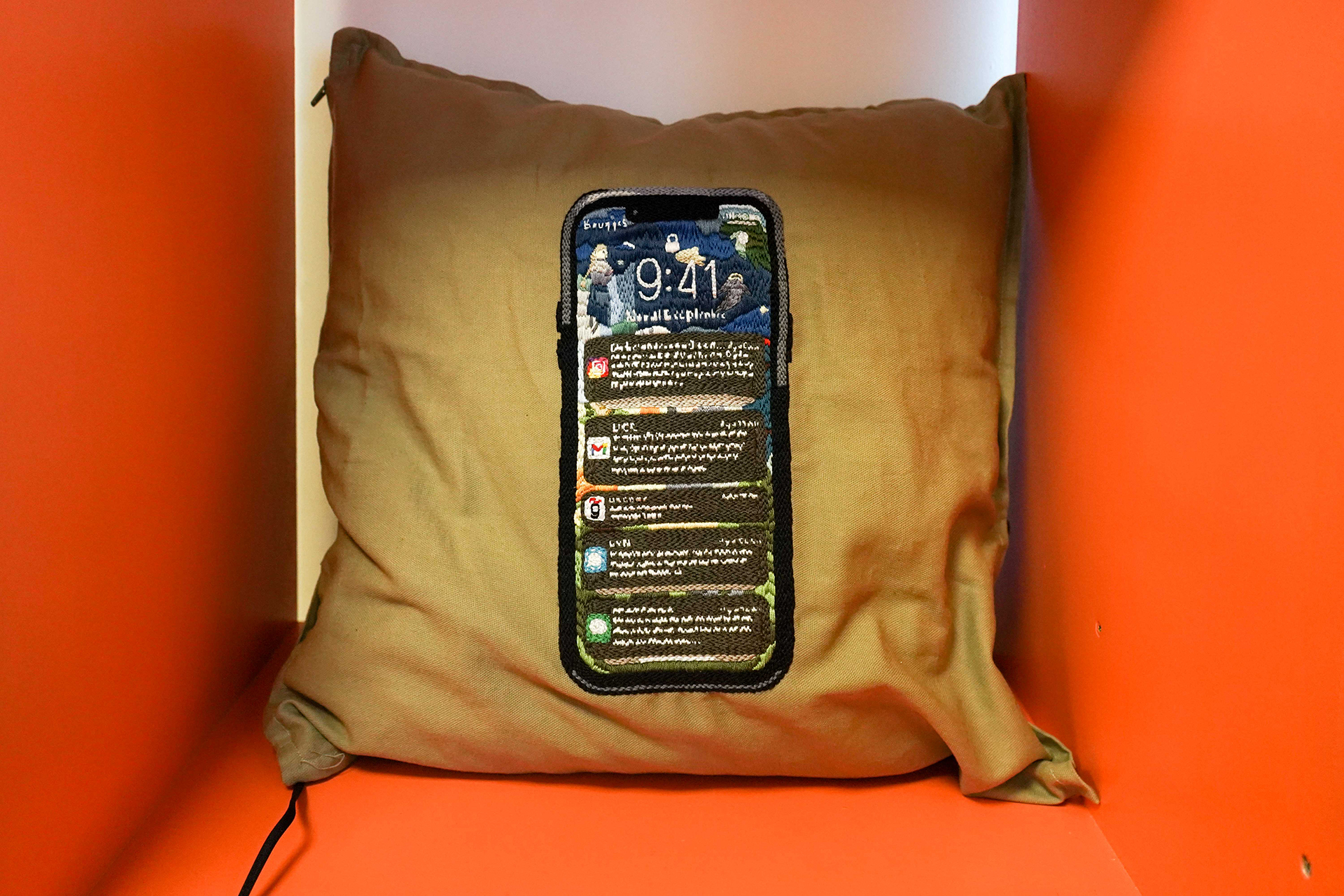
Technosommeil
Interactive hand embroidered pillow
Part of the collection of digital artworks of Mallapixels in the Val-de-Marne Département
2023
Technosommeil draws our attention to the object we increasingly spend our time with - the smartphone. The only time we seem to escape from looking at screens and checking notifications is when we're sleeping. Jonathan Crary in his book "24/7: Late Capitalism and the Ends of Sleep" says that "sleep is the only remining barrier, the only enduring "natural condition" that capitalism eliminate". But is that really so? Some of us already spend more time watching Netflix than sleeping, it seems capitalism could easily take over sleep in the long run. This project is a hand embroidered pillow which is also interactive. When you press it, you can hear a story, a myth, or an urban legend about someone's understanding of their devices. Computers and phones are becoming increasingly more complex with every update and new release to the point where none of us really understand how they function anymore. This project invites you to share your own story about how you understand your devices to complete the collection of technological folklore that inhabits the pillow.
Watch the pillow in action
This project was generously supported by Mallapixels and the Département Val-de-Marne.


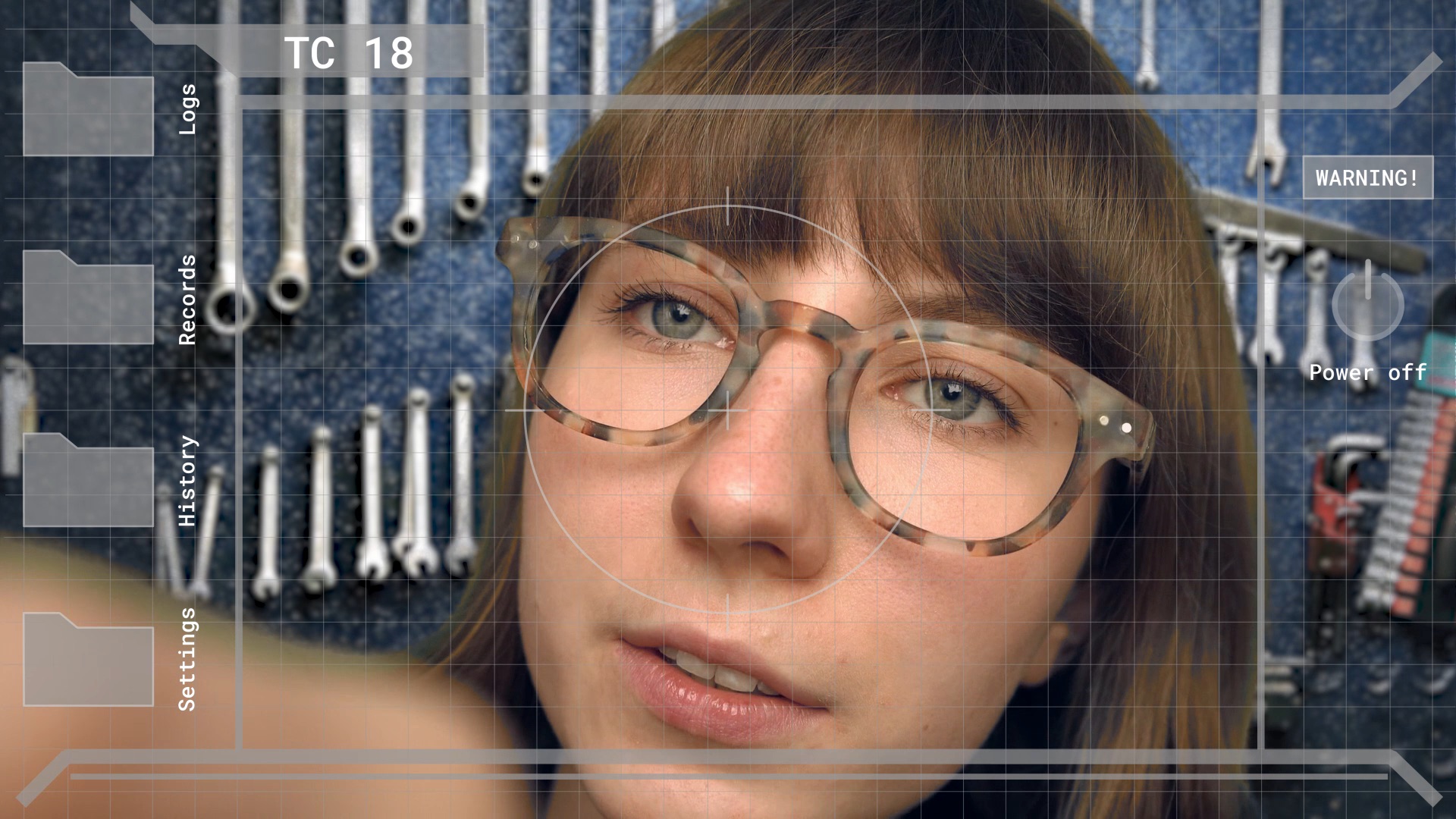

Let me fix you
ASMR video
Shown at Galerie D. | Tactical Tech | Bits und Bäume | ISEA 2023 | CAC La Traverse | Point Éphémère | SoMe festival | Torula
2022
ASMR as a rising form of online content reduces the body to a gamable center of pleasure to be derived from sensory stimuli, it betrays a willingness to perceive the human form as merely a loosely bound collection of mechanical systems vulnerable to exploitation. The subsection of ASMR videos specialized in “robot-repair” perhaps even more so. Focusing thematically on concerns surrounding the rise of robotic carers, this work draws attention to the decreased humanism in care, ethical boundaries regarding who is cared for and how, as well as to whom the responsibility to repair and maintain falls. Traditionally regarded as a female field, care and maintenance (spaces with limited growth potential) have been disregarded in portrayals of possible futures, preferring rather to dream of leaving behind a crumbling status quo to explore imagined vistas with space for endless expansion. ‘Let me fix you’ asks us to reassess our relationship to that which requires care and maintenance, and to attend to what is present as holistically valuable rather than divisible and exploitable.
watch the video in two parts here
Text by Niklas Ayris. This project was kindly supported by Mains d’Oeuvres, Réseau Diagonal, and the French Ministry of Culture




Be? Here? Now?
Website, video, installation
Produced and Exhibited at Kampnagel & Deichtorhallen
2022
Be? Here? Now? explores the nature of new forms of hybrid human existence in the technological age. The discourse on this topic tends to split into two opposing directions: the desire for total technological disengagement and the willingness to embrace the world of innovation unreservedly and naively.
Through a collection of resources assembled into a single website and displayed in the setting of a spatially elusive office space, “Be? Here? Now?” speaks to the emergence of mindfulness culture, specifically the emphasis it places on a "presentness" of consciousness mediated through technology. Through a collection of materials and reenactments presented on the website and inspired by the kitsch design of the 1990s and early 00s, the project creates a humorous collective reflection that is ultimately questioning what it means to have a "real" relationship in which one is "present.“
More about the work here
This artwork was created as part of the project "THEHOST.IS", a joint project of Deichtorhallen Hamburg GmbH and Kampnagel Internationale Kulturfabrik GmbH. It is part of the joint project "Diversify the Code! Artistic Production and Institutional Structural Change" which is funded by the Fonds Digital in the Kultur Digital programme of the Federal Cultural Foundation.




Center for Networked Intimacy: Workshop
Workshop
Held at Servus.at | Stereolux | iMAL
2021
Center for Networked Intimacy invites you to a workshop on the strategies and topics of conversation around the development of relationships in the digital era. The artificial nature of relationships formed with the help of technology has been becoming increasingly apparent since the invention of social networks, and the feelings of alienation and loneliness only escalated during the Covid-19 pandemic which forced upon us an environment of constant online connection.
During the workshop the participants will be introduced to the the idea of being ‘ambiently aware’ of another's actions, thoughts and experiences without having to be near them physically, and without specifically requesting such information. Following a discussion on the notion of ‘ambient awareness’, the participants will be invited to reflect on how such relationships have affected them and dedicate a personalized audio valentine to someone they feel close with only through social media.
More about the workshop here
This workshop was made possible with the support of Servus.at.



SAY YES TO GRAVE!
Video, interactive phone, installation
Exhibited at WHA Gallery, Kunstuniversität Linz | Galerie D.
2021
SAY YES TO GRAVE! is an infomercial for a fictional company that provides digital afterlife services. The work playfully examines digital maintenance from a relational perspective - who will manage the mass of digital information you have accumulated after your death? The acronym GRAVE is presented as a mnemonic device for remembering useful tips to ensure that your data is protected and that access to your files is given in a responsible way in order to avoid embarrassment after you die. The installation complements the infomercial by inviting viewers to work at the GRAVE call center by routing incoming calls from customers with complaints and queries about digital afterlife management.
Installation by Dasha Ilina and Erica Jewell
Video by Erica Jewell, Dasha Ilina, Lina Schwarzenberg
Sound recording by Aude Langlois
Camera work by Giacomo Piazzi
This project was made during the Silicon Friend Camp.
Watch the video

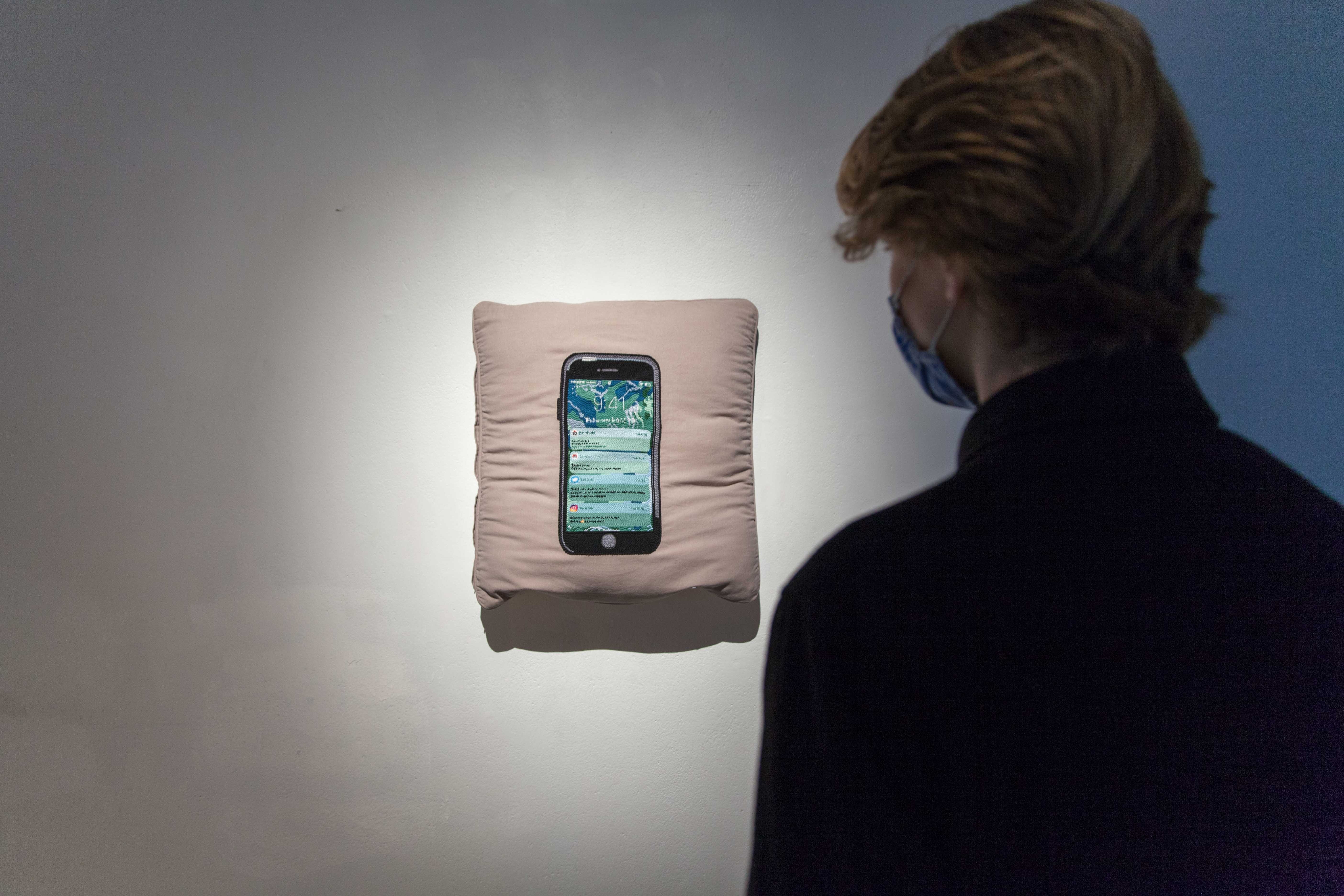
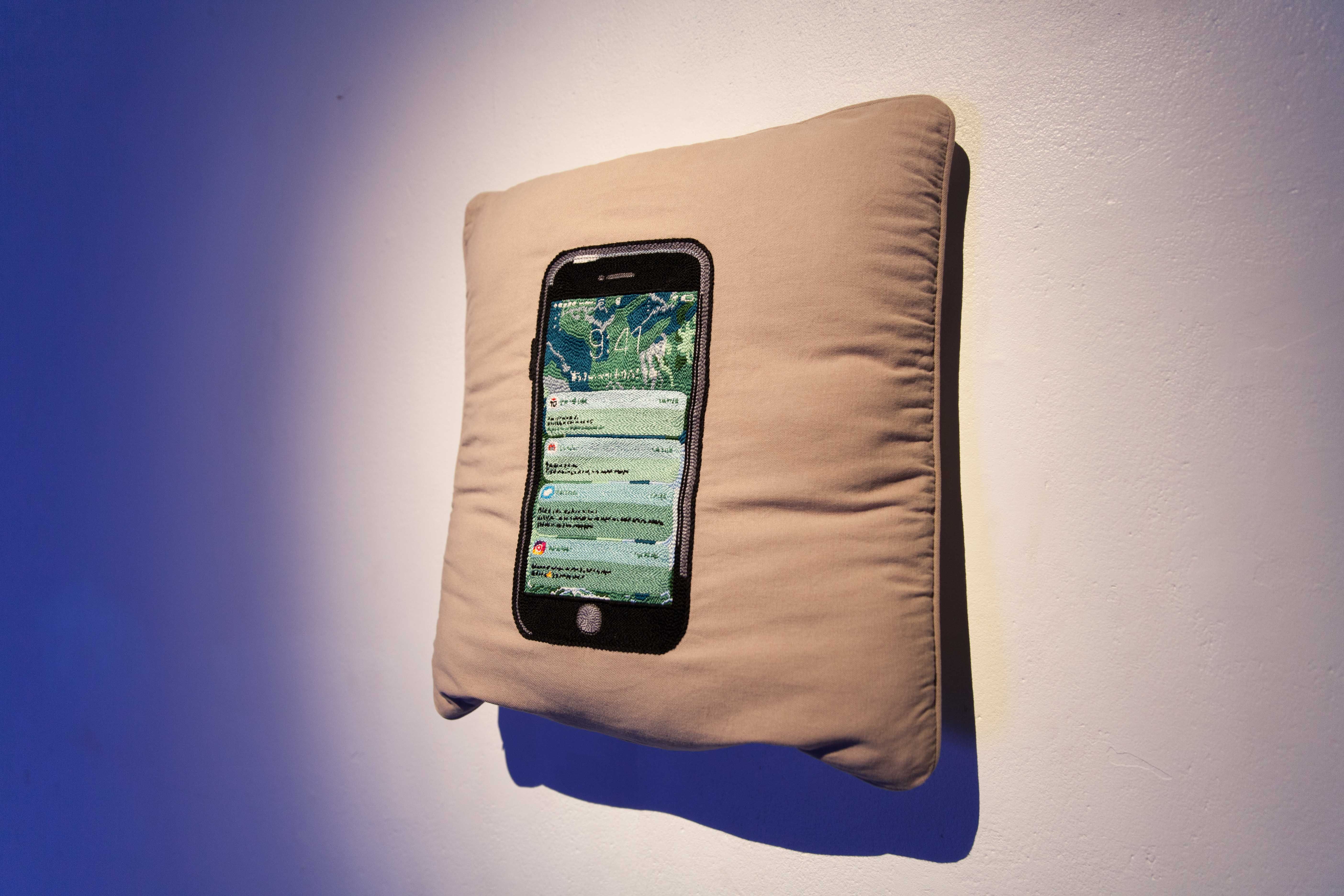

Do Humans Dream of Online Connection?
Installation of embroidery on a pillowcase
Exhibited at Mains d'Œuvres | Chroniques Biennale | CAC La Traverse | Espace Jean-Roger Caussimon | discotec
2021
‘Do humans dream of online connection?’ questions our everyday intimate relationships to objects in a time of heightened dissociation between physical proximity and emotional intimacy. The object unites the hard surfaces of technological interfaces with the fragility of delicate hand embroidery. Through using the somewhat outdated craft of embroidery and by highlighting the effort involved in its production, the object intends to strip the normally sleek experience of the smartphone as a tool considered only for its ability to serve a purpose, hiding the labor manifested through its usage. The work points out a progression in capitalist production by employing a tedious, monotonous physical task to question what in a contemporary Eurocentric context has been considered our most marketable resource. Namely personal time and attention being increasingly injected in the global economy by use of smart technology facilitating constant connectedness (and the increased capitalization of previously ‘free’ time). Due then to the increased dependence on technology as a means of maintaining human connection as a result of the COVID-19 pandemic consequent lockdowns, business has crept further into the mundane world of the individual, consuming what was previously unreachable.
Text by Niklas Ayris
This project was made with the support of Mains d'Œuvres.


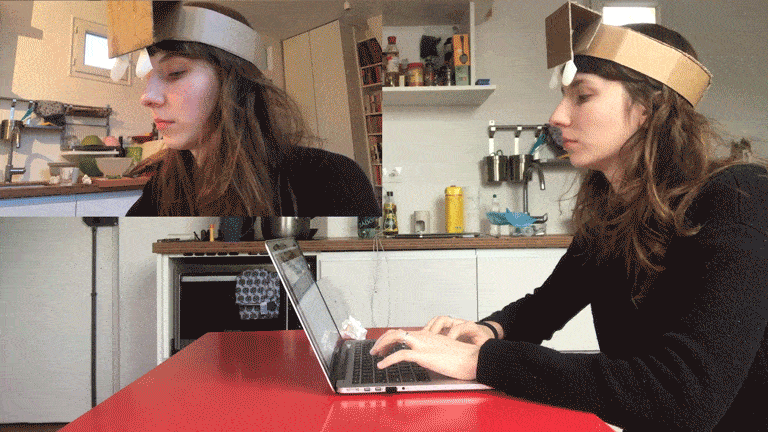

Center for Technological Pain
Video, objects, leaflets, installation
Exhibited at Le Botanique | Die Digitale | MU Artspace | La Gaîté Lyrique | HMKV at Dortmunder U | Ars Electronica | Mona Bismarck American Center | Institut Français | NeMe | Control Shift | Tactical Tech | Watermans Art Centre | discotec
2017-2020
Center for Technological Pain (CTP) is a mock company conceived by Dasha Ilina that offers DIY and open source solutions to solve health problems caused by digital technologies such as smartphones and laptops. Among the prototypes it has developed are mechanical eye shields that reduce eye-strain, a headset to free the user’s hands, an insomnia-free box and various more or less absurd contraptions to relieve strained elbows and fingers. Ilina, who is part of a generation of millennials who never take their eyes off their smartphone, also offers DIY manuals on how to build low-tech accessories from cheap materials. CTP further questions the negative effects of technology by adapting self-defense techniques to fight this contemporary addiction. (text by Marie Lechner)
Visit the work here

Choose Your Own Quarantine
Web-based game
Exhibited at Kontinuum (Kleine Humboldt Galerie) | Suoja/Shelter festival
2020
Choose Your Own Quarantine is a web-based game by Dasha Ilina and Sofia Haines that is inspired by the Choose Your Own Adventure books series first made popular in the 1980s. The game consists of three parts: Before, During, and After the quarantine. The user is presented with a scenario that initially follows the real timeline of COVID-19 development, but as the game goes on, users will notice that the options become increasingly speculative and fictitious. Choose Your Own Quarantine reflects the uncertainty of the current situation at large by showing the ways in which we attempt to reconcile our unexpected present with our unknown future. The various outcomes of the game are intended to raise questions as to which values, practices, and cultures will ultimately be enduring, and which may become outdated remnants of the pre-pandemic world.
In collaboration with Sofia Haines.
Play online




Rite de Passage
Video
2019
Rite de passage is a video work that explores the initiation of two characters into the archive they are attempting to negate. Blindfolded, they experience the world only through sound and touch.
While searching for the origins of mystical sounds they are disrupted by, they come to find materializations of memories of the space.
The material record is always fragmentary—it cannot fully capture an original event—details, perspectives, and subjectivities are always missing. The characters can only experience the sounds of the original events while they are unified with them through the physical experience of a common space. The gaps in the record are thus left to be fleshed in through the subjectivities of the characters. In this way, archives are dynamically generated in real time, through the praxis of anyone who experiences them, they are forever re-contextualized and re-authored through such an experience.
In collaboration with Kurtis Lesick.
visit the work here




www.send-me-a-task.com
Performance
Performed at Plateforme gallery
2017
www.send-me-a-task.com is an online service directing artists Dasha Ilina and Amanda Lewis to fulfill algorithmic tasks emulating the demanding workflow that workers subjected to gig economy standards experience every day. During the performance, the visitors are invited to send a task for the artists to perform during the entirety of the exhibition. The artists will perform the task as soon as they see the changes on the screen. The show is also recorded and streamed on youtube, so that users can send tasks from a distance. The tasks are simple and stereotypical to the activities usually performed at gallery openings, and range from Have a sip of your drink to Debate art politics or Confront each other about what happened last night.
The reason for the performance came from research on the workflow of the gig economy, specifically mechanical turk. While reading interviews with turkers that attempted to work on the mechanical turk as their primary (and often only) source of income, the artists found out that many turkers were so attached to their computers, so as to not miss a HIT (Human Intelligence Task), they would not leave their screens at all (even wake up in the middle of the night to complete the tasks). Therefore the performance is an emulation of the lifestyle of gig economy workers.
In collaboration with Amanda Lewis.
Visit the work here
